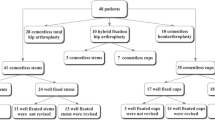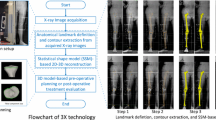Abstract
The number of total hip arthroplasties is continuously rising. Although less invasive surgical techniques, sophisticated component design, and intraoperative navigation techniques have been introduced, the rate of peri- and postoperative complications, including dislocations, fractures, nerve palsies, and infections, is still a major clinical problem. Better patient outcome, faster recovery and rehabilitation, and shorter operation times therefore remain to be accomplished. A promising strategy is to use minimally invasive techniques in conjunction with modular implants, aimed at independently reconstructing femoral offset and leg length on the basis of highly accurate preoperative planning. Plain radiographs have clear limitations for the correct estimation of hip joint geometry and bone quality. Three-dimensional assessment based on computed tomography (CT) allows optimizing the choice and positions of implants and anticipating difficulties to be encountered during surgery. Postoperative CT is used to monitor operative translation and plays a role in arthroplastic quality management. Radiologists should be familiar with the needs of orthopedic surgeons in terms of CT acquisition, post-processing, and data transfer. The CT protocol should be optimized to enhance image quality and reduce radiation exposure. When dedicated orthopedic CT protocols and state-of-the-art scanner hardware are used, radiation exposure can be decreased to a level just marginally higher than that of conventional preoperative radiography. Surgeons and radiologists should use similar terminology to avoid misunderstanding and inaccuracies in the transfer of preoperative planning.








Similar content being viewed by others
References
Kiefer H. Differences and opportunities of THA in the USA, Asia and Europe. In: Chang J-D, Billau K, editors. Bioceramics and alternative bearings in joint arthroplasty. 12th BIOLOX Symposium Proceedings. Darmstadt, Germany: Steinkopff-Verlag; 2007. p. 3–8.
Malik A, Dorr LD. The science of minimally invasive total hip arthroplasty. Clin Orthop Relat Res. 2007;463:74–84.
Woolson ST. In the absence of evidence–why bother? A literature review of minimally invasive total hip replacement surgery. Instr Course Lect. 2006;55:189–93.
Soohoo NF, Farng E, Lieberman JR, Chambers L, Zingmond DS. Factors that predict short-term complication rates after total hip arthroplasty. Clin Orthop Relat Res. 2010;468:2363–71.
Goosen JH, Kollen BJ, Castelein RM, Kuipers BM, Verheyen CC. Minimally invasive versus classic procedures in total hip arthroplasty: a double-blind randomized controlled trial. Clin Orthop Relat Res. 2011;469:200–8.
Flecher X, Parratte S, Aubaniac JM, Argenson JN. Three-dimensional custom-designed cementless femoral stem for osteoarthritis secondary to congenital dislocation of the hip. J Bone Joint Surg (Br). 2007;89:1586–91.
Sariali E, Mouttet A, Pasquier G, Durante E, Catone Y. Accuracy of reconstruction of the hip using computerised three-dimensional pre-operative planning and a cementless modular neck. J Bone Joint Surg (Br). 2009;91(3):333–40.
Ilchmann T, Gersbach S, Zwicky L, Clauss M. Standard transgluteal versus minimal invasive anterior approach in hip arthroplasty: a prospective, consecutive cohort study. Orthop Rev (Pavia). 2013;5:e31.
Dorr LD, Thomas D, Long WT, Polatin PB, Sirianni LE. Psychologic reasons for patients preferring minimally invasive total hip arthroplasty. Clin Orthop Relat Res. 2007;458:94–100.
Ciminiello M, Parvizi J, Sharkey PF, Eslampour A, Rothman RH. Total hip arthroplasty: is small incision better? J Arthroplasty. 2006;21:484–8.
Chimento GF, Pavone V, Sharrock N, Kahn B, Cahill J, Sculco TP. Minimally invasive total hip arthroplasty: a prospective randomized study. J Arthroplasty. 2005;20:139–44.
Wright JM, Crockett HC, Delgado S, Lyman S, Madsen M, Sculco TP. Mini-incision for total hip arthroplasty: a prospective, controlled investigation with 5-year follow-up evaluation. J Arthroplasty. 2004;19:538–45.
Kennon RE, Keggi JM, Wetmore RS, Zatorski LE, Huo MH, Keggi KJ. Total hip arthroplasty through a minimally invasive anterior surgical approach. J Bone Joint Surg Am. 2003;85 Suppl 4:39–48.
Matta JM, Shahrdar C, Ferguson T. Single-incision anterior approach for total hip arthroplasty on an orthopaedic table. Clin Orthop Relat Res. 2005;441:115–24.
Woolson ST, Mow CS, Syquia JF, Lannin JV, Schurman DJ. Comparison of primary total hip replacements performed with a standard incision or a mini-incision. J Bone Joint Surg Am. 2004;86-A(7):1353–8.
Husmann O, Rubin PJ, Leyvraz PF, de Roguin B, Argenson JN. Three-dimensional morphology of the proximal femur. J Arthroplasty. 1997;12:444–50.
Krishnan SP, Carrington RW, Mohiyaddin S, Garlick N. Common misconceptions of normal hip joint relations on pelvic radiographs. J Arthroplasty. 2006;2:409–12.
Asayama I, Chamnongkich S, Simpson KJ, Kinsey TL, Mahoney OM. Reconstructed hip joint position and abductor muscle strength after total hip arthroplasty. J Arthroplasty. 2005;20:414–20.
Jolles BM, Zangger P, Leyvraz PF. Factors predisposing to dislocation after primary total hip arthroplasty: a multivariate analysis. J Arthroplasty. 2002;17:282–8.
Ng VY, Kean JR, Glassman AH. Limb-length discrepancy after hip arthroplasty. J Bone Joint Surg Am. 2013;95:1426–36.
Benedetti MG, Catani F, Benedetti E, Berti L, Di Gioia A, Giannini S. To what extent does leg length discrepancy impair motor activity in patients after total hip arthroplasty? Int Orthop. 2010;34:1115–21.
Marcucci M, Indelli PF, Latella L, Poli P, King D. A multimodal approach in total hip arthroplasty preoperative templating. Skelet Radiol. 2013;42:1287–94.
Bertz A, Indrekvam K, Ahmed M, Englund E, Sayed-Noor AS. Validity and reliability of preoperative templating in total hip arthroplasty using a digital templating system. Skeletal Radiol. 2012;41:1245–9.
Kosashvili Y, Shasha N, Olschewski E, Safir O, White L, Gross A, et al. Digital versus conventional templating techniques in preoperative planning for total hip arthroplasty. Can J Surg. 2009;52:6–11.
Linclau L, Dokter G, Peene P. Radiological aspects in preoperative planning and postoperative assessment of cementless total hip arthroplasty. Acta Orthop Belg. 1993;59:163–7.
Sugano N, Ohzono K, Nishii T, Haraguchi K, Sakai T, Ochi T. Computed-tomography-based computer preoperative planning for total hip arthroplasty. Comput Aided Surg. 1998;3:320–4.
Sariali E, Mouttet A, Pasquier G, Durante E. Three-dimensional hip anatomy in osteoarthritis. Analysis of the femoral offset. J Arthroplasty. 2009;24:990–7.
Lee CH, Goo JM, Ye HJ, Ye SJ, Park CM, Chun EJ, et al. Radiation dose modulation techniques in the multidetector CT era: from basics to practice. Radiographics. 2008;28:1451–9.
Kalteis T, Handel M, Herold T, Perlick L, Paetzel C, Grifka J. Position of the acetabular cup—accuracy of radiographic calculation compared to CT-based measurement. Eur J Radiol. 2006;58:294–300.
Huppertz A, Radmer S, Asbach P, Juran R, Schwenke C, Diederichs G, et al. Computed tomography for preoperative planning in minimal-invasive total hip arthroplasty: Radiation exposure and cost analysis. Eur J Radiol. 2011;78:406–13.
Wall BF, Hart D. Revised radiation doses for typical X-ray examinations. Report on a recent review of doses to patients from medical X-ray examinations in the UK by NRPB. National Radiological Protection Board. Br J Radiol. 1997;70:437–9.
Jurik AG, Jensen LC, Hansen J. Total effective radiation dose from spiral CT and conventional radiography of the pelvis with regard to fracture classification. Acta Radiol. 1996;37:651–4.
Al-Malki MA, Abulfaraj WH, Bhuiyan SI, Kinsara AA. A study on radiographic repeat rate data of several hospitals in Jeddah. Radiat Prot Dosim. 2003;103:323–30.
Sayed-Noor AS, Hugo A, Sjödén GO, Wretenberg P. Leg length discrepancy in total hip arthroplasty: comparison of two methods of measurement. Int Orthop. 2009;33:1189–93.
Terry MA, Winell JJ, Green DW, Schneider R, Peterson M, Marx RG, et al. Measurement variance in limb length discrepancy: clinical and radiographic assessment of interobserver and intraobserver variability. J Pediatr Orthop. 2005;25:197–201.
Aitken AG, Flodmark O, Newman DE, Kilcoyne RF, Shuman WP, Mack LA. Leg length determination by CT digital radiography. AJR Am J Roentgenol. 1985;144:613–5.
Sabharwal S, Kumar A. Methods for assessing leg length discrepancy. Clin Orthop Relat Res. 2008;466:2910–22.
Escott BG, Ravi B, Weathermon AC, Acharya J, Gordon CL, Babyn PS, et al. EOS low-dose radiography: a reliable and accurate upright assessment of lower-limb lengths. J Bone Joint Surg Am. 2013;95:e1831–7.
Tannast M, Langlotz U, Siebenrock KA, Wiese M, Bernsmann K, Langlotz F. Anatomic referencing of cup orientation in total hip arthroplasty. Clin Orthop Relat Res. 2005;436:144–50.
Tannast M, Murphy SB, Langlotz F, Anderson SE, Siebenrock KA. Estimation of pelvic tilt on anteroposterior X-rays–a comparison of six parameters. Skelet Radiol. 2006;35:149–55.
Murray DW. The definition and measurement of acetabular orientation. J Bone Joint Surg (Br). 1993;75:228–32.
Lewinnek GE, Lewis JL, Tarr R, Compere CL, Zimmerman JR. Dislocations after total hip-replacement arthroplasties. J Bone Joint Surg Am. 1978;60:217–20.
Murtha PE, Hafez MA, Jaramaz B, DiGioia 3rd AM. Variations in acetabular anatomy with reference to total hip replacement. J Bone Joint Surg (Br). 2008;90:308–13.
Widmer KH. Containment versus impingement: finding a compromise for cup placement in total hip arthroplasty. Int Orthop. 2007;31 Suppl 1:S29–33.
Iwai S, Kabata T, Maeda T, Kajino Y, Kuroda K, Fujita K, et al. Using simulation before and after rotational acetabular osteotomy to assess the femoroacetabular impingement. Bone Joint J. 2013;95-B(Suppl 15):203.
Grupp TM, Weik T, Bloemer W, Knaebel HP. Modular titanium alloy neck adapter failures in hip replacement–failure mode analysis and influence of implant material. BMC Musculoskelet Disord. 2010;11:3.
Bosker BH, Verheyen CC, Horstmann WG, Tulp NJ. Poor accuracy of freehand cup positioning during total hip arthroplasty. Arch Orthop Trauma Surg. 2007;127:375–9.
Beckmann J, Stengel D, Tingart M, Götz J, Grifka J, Lüring C. Navigated cup implantation in hip arthroplasty. Acta Orthop. 2009;80:538–44.
Murphy SB, Ecker TM, Tannast M. THA performed using conventional and navigated tissue-preserving techniques. Clin Orthop Relat Res. 2006;453:160–7.
Jaramaz B, DiGioia 3rd AM, Blackwell M, Nikou C. Computer assisted measurement of cup placement in total hip replacement. Clin Orthop Relat Res. 1998;354:70–81.
Sendtner E, Boluki D, Grifka J. Current state of doing minimal invasive total hip replacement in Germany, the use of new implants and navigation–results of a nation-wide survey. Z Orthop Unfall. 2007;145:297–302.
Sotereanos NG, Miller MC, Smith B, Hube R, Sewecke JJ, Wohlrab D. Using intraoperative pelvic landmarks for acetabular component placement in total hip arthroplasty. J Arthroplasty. 2006;21:832–40.
Steppacher SD, Kowal JH, Murphy SB. Improving cup positioning using a mechanical navigation instrument. Clin Orthop Relat Res. 2011;469:423–8.
Conflict of interest
Alexander Huppertz has been a full time paid employee of Siemens AG since 1 June 2004. He is Associate Director of the Imaging Science Institute Charité. The Institute is a scientific cooperation between the Charité, University Hospitals of Berlin, Germany and Siemens Healthcare in the form of a private–public partnership (PPP). Sebastian Radmer and Martin Sparmann received speakers’ honoraria for specific speeches from Symbios Orthopédie SA, Switzerland.
Author information
Authors and Affiliations
Corresponding author
Rights and permissions
About this article
Cite this article
Huppertz, A., Radmer, S., Wagner, M. et al. Computed tomography for preoperative planning in total hip arthroplasty: what radiologists need to know. Skeletal Radiol 43, 1041–1051 (2014). https://doi.org/10.1007/s00256-014-1853-2
Received:
Revised:
Accepted:
Published:
Issue Date:
DOI: https://doi.org/10.1007/s00256-014-1853-2




